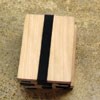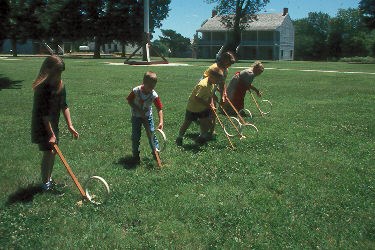
Even though boys and girls worked hard, they always found time for fun. Many children today have a huge variety of toys, games, and activities from which to choose. Children of the fort had to amuse themselves with simple games and a few homemade toys. Most of these games were played outdoors, using objects found around the fort. An old barrel hoop provided hours of fun when it was rolled with a stick. With a bit of pretending, a fence could be a bucking horse to ride. A sturdy board laid over a tree stump became a simple seesaw. Rocks, leaves, and branches created imaginary houses and forts. A child's only limit was his or her imagination. 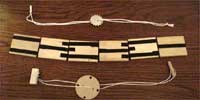
Jacob's Ladder - The Jacob's Ladder toy was very popular in the late 1800s. It was made of several flat wooden blocks that were connected with ribbons. When held correctly, it looked as if one block were tumbling down over the blocks beneath it. A child could also make a chair, table, star, animals, and other shapes by holding the end blocks and moving the Jacob's Ladder with two hands. The name Jacob's Ladder comes from a story in the Bible. Jacob, whose descendants became the people of Israel, was on a journey across the desert. One night, he had a dream. He saw hundreds of angels moving up and down a ladder between heaven and earth. The Jacob's Ladder toy looks and moves like a person descending a ladder. Because of the religious nature of the toy, Puritan children could play with it on Sunday, and it was known as a Sunday toy.
Buzz Saw - Noise making toys have fascinated children the world over for centuries. The buzz saw is one of the most popular noise makers of all times. It produces a buzzing sound similar to that made by a circular saw. These toys were made from coins. Later, they were made from wood chips, buttons, and circular-sawn or turned wood. In the days of the one-room schoolhouse, boys at school would often run a buzz saw into the pigtails of girls sitting at the desks in front of them. 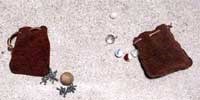
Marbles - Marbles were made of stone, pottery, clay, or china. Some had colorful swirls or strange designs. Children who had no marbles used musket balls, nuts, or hard berries to play instead. Marble collections were always changing, as children won, lost, and traded their marbles. A big bag of marbles was considered a treasure. Losing at marbles was very disappointing. Perhaps the expression, "lost their marbles," began as a description of an angry loser!
Jacks - The game of jacks was played with small six-pronged objects called jackstones, or jacks. The first player started the game by throwing the jackstones on the ground. The other players then took turns tossing one jack into the air, picking up another jack from the ground, and then catching the flying jack as it came back down-all with the same hand! In the next rounds, players tried to grab two jacks, then three, then four. If someone failed to pick up enough jacks, or allowed the flying jack to hit the ground, that person was out of the game.
Tops - Tops were favorite toys with both boys and girls. They came in many different styles. Some were wound up with a string. Others had a long, round stem for spinning. Peg tops were the most common kind of top. They were made of a single carved piece of wood. A humming top was hollow and had a hole in one side. When it spun, it made a whistling or humming noise. Conqueror was an exciting game. Two players spun their tops so that the tops bounced against each other. The top that knocked the other over, while staying upright itself, was the winner. In other games, competitors tried to spin a top onto a target or see whose top could spin the longest. 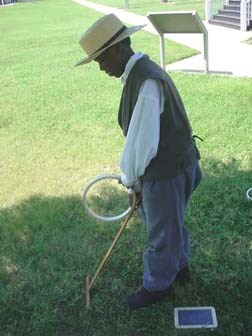
Hoop and Stick - A wooden or metal hoop could provide hours of fun. Boys and girls raced their hoops across the schoolyard. In order to keep the hoops upright, children guided them with a stick. Contests were held to test hoop-rolling skills. Sometimes participants had to guide their hoops through obstacle courses. In other contests, children tried to keep several hoops rolling at once.
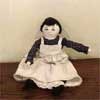
Dolls - Parents encouraged their daughters to play with dolls so they could practice being good mothers. Girls also tested their sewing skill by making doll clothes.
Homemade dolls - In rural areas, people fashioned dolls out of the materials at hand. Some carved dolls from pieces of wood or sewed rag dolls from cloth or deerskin. Doll heads were sometimes made from dried apples. "Apple dolls" resembled very old, wrinkled people. Even cornhusks could be bent and tied to make a doll.
A variety of dolls - Toy makers created a variety of dolls in the 1800s. Most looked like adults. Dolls that resembled babies were not made until the late 1800s. Most dolls had wooden bodies. Many had joints at the elbows, hips, and knees so that children could bend their arms and legs. Doll heads were made of wood, papier-mâché, wax, or china. Dolls with wax heads were the most costly. They had glass eyes and natural-looking hair. Some even had real human hair·
Fashionable dolls - Some doll clothes were simple, but others were quite fancy with ribbons, ruffles, and lace. Sometimes a doll was so beautifully dressed that its owner was only allowed to play with it on Sunday, and then only with clean hands. Some dolls were not to be touched by children at all.
The information for this page came from Old Time Toys by Bobbie Kalman, published by Crabtree Publishing Company. Used by permission. |
Last updated: July 30, 2016

